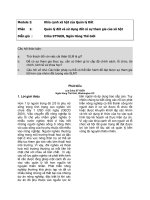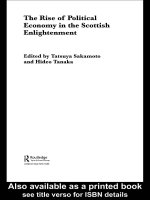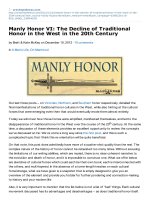The politics of agrarian reform in brazil the landless rural workers movement
Bạn đang xem bản rút gọn của tài liệu. Xem và tải ngay bản đầy đủ của tài liệu tại đây (1.75 MB, 245 trang )
The Politics of Agrarian Reform in Brazil
SOCIAL MOVEMENTS AND TRANSFORMATION
This series tackles one of the central issues of our time: the rise of
large-scale social movements and the transformation of society over
the last thirty years. As global capitalism continues to affect broader
segments of the world’s population—workers, peasants, the selfemployed, the unemployed, the poor, indigenous peoples, women,
and minority ethnic groups—there is a growing mass movement by
the affected populations to address the inequities engendered by the
globalization process. These popular mass movements across the
globe (such as labor, civil rights, women’s, environmental, indigenous,
and anti-corporate globalization movements) have come to form a
viable and decisive force to address the consequences of the operations of the transnational corporations and the global capitalist system. The study of these social movements—their nature, social base,
ideology, and strategy and tactics of mass struggle—is of paramount
importance if we are to understand the nature of the forces that are
struggling to bring about change in the global economy, polity, and
social structure. This series aims to explore emerging movements
and develop viable explanations for the kind of social transformations
that are yet to come.
Series Editor:
Berch Berberoglu is Professor of Sociology and Director of Graduate
Studies in Sociology at the University of Nevada, Reno.
Titles:
Social Movements in Latin America: Neoliberalism and Popular
Resistance
James Petras and Henry Veltmeyer
Challenging Neoliberalism at Turkey’s Gezi Park: From Private
Discontent to Collective Class Action
Efe Can Gürcan and Efe Peker
Labor Activists and the New Working Class in China: Strike Leaders’
Struggles
Parry P. Leung
The Politics of Agrarian Reform in Brazil: The Landless Rural Workers
Movement
Wilder Robles and Henry Veltmeyer
The Politics of Agrarian Reform in Brazil
The Landless Rural Workers Movement
Wilder Robles and Henry Veltmeyer
THE POLITICS OF AGRARIAN REFORM IN BRAZIL
Copyright © Wilder Robles and Henry Veltmeyer, 2015.
Softcover reprint of the hardcover 1st edition 2015 978-1-137-51719-7
All rights reserved.
First published in 2015 by
PALGRAVE MACMILLAN®
in the United States— a division of St. Martin’s Press LLC,
175 Fifth Avenue, New York, NY 10010.
Where this book is distributed in the UK, Europe and the rest of the world,
this is by Palgrave Macmillan, a division of Macmillan Publishers Limited,
registered in England, company number 785998, of Houndmills,
Basingstoke, Hampshire RG21 6XS.
Palgrave Macmillan is the global academic imprint of the above companies
and has companies and representatives throughout the world.
Palgrave® and Macmillan® are registered trademarks in the United States,
the United Kingdom, Europe and other countries.
ISBN 978-1-349-57747-7
ISBN 978-1-137-51720-3 (eBook)
DOI 10.1057/9781137517203
Library of Congress Cataloging-in-Publication Data
Robles, Wilder.
The politics of agrarian reform in Brazil : the landless rural workers
movement / by Wilder Robles and Henry Veltmeyer.
pages cm.—(Social movements and transformation)
Includes bibliographical references and index.
1. Land reform—Brazil. 2. Agricultural laborers—Brazil. 3. Rural poor—
Brazil. I. Veltmeyer, Henry. II. Title.
HD1333.B7R63 2015
333.3Ј181—dc23
2015003953
A catalogue record of the book is available from the British Library.
Design by Newgen Knowledge Works (P) Ltd., Chennai, India.
First edition: August 2015
10 9 8 7 6 5 4 3 2 1
For Jorge Nef,
Wonderful teacher, mentor, colleague, friend
Contents
List of Figures and Tables
ix
Preface
xi
Acknowledgments
xv
List of Brazilian Presidents, 1985 to Present
xvii
List of Abbreviations
xix
Introduction
1
1
The Agrarian Question Today: The Politics of
Poverty and Inequality
17
2
Rural Development and Social Movements
37
3
The Politics of Agrarian Reform in Brazil:
A Historical Background
65
4
Agrarian Reform under Sarney and Collor de Mello-Franco
85
5
Agrarian Reform under Cardoso
105
6
Agrarian Reform under “Lula” da Silva and Rousseff
125
7
Cooperative Experiences
143
8
Popular Agrarian Reform
171
Conclusion
189
Notes
197
Bibliography
215
Index
227
Figures and Tables
Figures
0.1 Gini index of land inequality in Brazil, 1985–2006
4
0.2 Gini index of income inequality in Brazil, 1980–2009
6
0.3 Alternative numbers of agrarian reform beneficiaries in
Brazil, 1985–2012
8
1.1 Gini index of global income inequality, 1820–2002
20
1.2 Land occupations in Brazil, 1988–2012
30
1.3 Participation of Brazilian landless peasant families in
land occupations, 1988–2012
31
3.1 Evolution of rural movements engaged in land
occupations in Brazil, 2000–2012
66
4.1 Murder of peasants in land confl icts in Brazil, 1985–2013 99
6.1 Brazilian GDP annual growth, 1995–2013
129
7.1 Number of established agrarian reform settlements,
1985–2012
144
Tables
0.1 Distribution of agricultural landownership in Brazil, 2006
4
0.2 Official Brazilian government numbers of agrarian
reform beneficiaries, 1964–2013
7
1.1 Regional breakdown of people living on US $1.25 per day,
1981–2010
19
1.2 Land occupations by regions and participation of
Brazilian landless peasant families, 1988–2012
32
1.3 People living in poverty and absolute poverty in
Latin America and Caribbean, 1980–2012
34
5.1 Number of agrarian reform beneficiaries, 1995–2013
110
7.1 Number of established agrarian reform settlements and
landless peasant families settled, 1979–2012
143
Preface
This book focuses on the macro-and microfactors that have shaped
the processes of peasant mobilization, agrarian reform, and cooperative formation in contemporary Brazil. Specifically, this study examines the role of the Movimento dos Trabalhadores Rurais Sem Terra,
or Landless Rural Workers Movement (MST) in the process. This
study turned out to be quite a challenge. At an earlier stage of this
study, one of the authors, Wilder Robles, in the context of collecting
data for his doctoral dissertation, was interested only in examining
the interrelationships among peasant mobilization, agrarian reform,
and cooperative formation through the macroanalysis of three closely
related processes: democracy, globalization, and social movements.
However, he soon found that this approach had serious limitations.
During his stays in many MST and in other encampments and settlements, he discovered a multitude of problems the landless peasants
faced. There were internal conflicts, ideological differences, limited
material resources, and lack of access to technology and markets.
Some of these problems were beyond the landless peasants’ control.
Nevertheless, they were determined to advance agrarian reform. He
soon realized that the struggle for agrarian reform and the struggle
for cooperative formation were two interconnected struggles, requiring different albeit complementary analyses.
Thus, Robles was gradually drawn to explore the aforementioned interrelationships via a microanalysis of three closely related
processes—community building, grassroots democracy, and sustainable livelihoods. Eventually, he came to appreciate the importance
of integrating this microanalysis with a macrolevel structural and
political analysis of the dynamics of capitalist development. The
coauthor of this book, Henry Veltmeyer, based on years of study
and field research on capitalist development, contributed with this
macrolevel class analysis perspective, which is needed to understand
xii
Preface
the “big picture,” that is, the dynamic inner workings of the world
capitalist system that generate the forces at play in the production
of poverty, inequality, and exclusion, and the resulting class conflict. Ultimately, an integrated micro-macroanalysis is fundamental
for devising effective community-based development programs that
respond to the needs, goals, and expectations of the rural poor. This
study has been a highly rewarding experience for the authors. We
have witnessed firsthand both the fulfilled and unfulfilled hopes of
the landless peasants to have land of their own. We have also witnessed the successes and failures of peasant cooperatives, allowing
us to reflect on their meaning, scope, and limitations. These experiences have strengthened our belief that an ongoing and concerted
peasant mobilization is indispensable for promoting agrarian reform.
They also have reinforced our belief that the state has to play an
active role in consolidating agrarian reform. True enough, peasant
movements are key to promoting agrarian reform. However, these
movements have their limitations. To overcome these limitations,
these movements must be closely connected to the academic and
research communities. Unfortunately, there is a growing dissociation
today between academia and society, and between theoreticians and
practitioners. Certainly, this is the case in the international development studies community today. The interaction between theoreticians and practitioners is superficial and shortterm in scope. This
unhealthy situation prevents a lively, ongoing dialogue, and collaboration between both parties.
What is also true is that the MST has made efforts to overcome
this situation: it has linked academics, researchers, students, workers, women, and children to a reflection-action agrarian reform project. Unfortunately, the strength and scope of this solidarity linkage
varies from region to region due to a multitude of factors beyond
the landless peasants’ control. The uneven structure of this linkage
either strengthens or weakens the overall struggle for agrarian transformation. On their own, landless peasants will have difficulties in
consolidating agrarian reform. The forces standing against them
are simply too powerful. Yet, the system created by these powerful
forces is not immutable. It suffers from built-in contradictions and a
propensity toward crisis that results in the development of not only
forces of popular resistance, but also fissures generated by the crisis
that creates windows of opportunities for the mobilization of these
forces. Thus, it is imperative that academic researchers and peasants
work together in order to advance concrete strategies of progressive
Preface
xiii
social change—strategies that require a close look at the forces at
play and dictate a concrete analysis of the situation in which the
“wretched of the earth” (as the supra-poor were described by Frans
Fanon) find themselves. It is here that academics and researchers,
even those from the North America who do not have to “live” the
conditions experienced by them, can play a useful role in advancing
the struggle.
Like any study of this scope, this study has its shortcomings too.
Some scholars are likely to argue that it does not pay enough attention
to nonpeasant actors in the struggle for agrarian reform, or that its
analysis of the political forces contesting or resisting agrarian reform
is very limited. Other scholars are likely to argue that this study treats
landless peasants as subjects, and not objects, of their own history, or
that its analysis of class and ethnicity in “new” social movements is
very superficial or nearly absent. All of these are valid questions that
require clear answers. Our response is very simple: this is an interdisciplinary study that aims to provide a broad but critical overview of
the complex processes of peasant mobilization, agrarian reform, and
cooperative formation. The beauty of interdisciplinary studies is that
it opens windows from which one can appreciate the landscape of the
subject of study and identify its main components. This is the purpose
of this study. We hope discipline-specific scholars—anthropologists,
historians, and sociologists in particular—will be motivated to further examine issues not fully explored in this book.
Acknowledgments
We are deeply indebted to many people for the help and guidance
they provided us during the research and writing of this book. In particular, we would like to express our deepest gratitude to João Pedro
Stédile, Wanusa Santos, and Geraldo Fontes, present and former
members of the MST’s National Co-ordination and Secretariat, for
their friendship and assistance. Our deep thanks also to the Comissão
Pastoral da Terra (CPT), or Catholic Church Commission on Land
Reform, for giving us access to their database and other valuable
resources during summer research visits to Brazil. We also wish to
thank Aguinel Fonseca and Sister Ozania, dedicated staff members of
this progressive Catholic organization, for their enormous assistance
with visits to MST encampments and settlements in many parts of
Brazil. We would also like to thank from the bottom of our heart
our dearest friend, colleague, and companheiro de luta Bernardo
Mançano Fernandes, director of the Centre for Studies on Land
Reform (NERA) and professor of Geography at the Universidade
Estadual Paulista (Unesp), for his unlimited help in collecting data
on the MST and land issues. Finally, we wish to express our deepest
gratitude to the anonymous reviewers for their helpful feedback on
several drafts of this manuscript.
Brazilian Presidents, 1985 to Present
President
In Office
Tancredo Neves
Neves was elected by the Brazilian Congress
on January 15, 1985. He became seriously
ill just days before his swearing-in ceremony
of March 15, 1985. Neves died on April 21,
1985. He was replaced by his vice president,
José Sarney.
José Sarney
March 15, 1985, to March 14, 1990.
Fernando Collor de Mello
March 15, 1990, to October 2, 1992.
He was the first president elected by free,
direct popular vote since the military coup
of 1964. He was impeached by the Brazilian
Congress for corruption and replaced by his
vice president, Itamar Franco.
Itamar Franco
October 2, 1992, to December 31, 1994.
Fernando Henrique Cardoso
January 1, 1995, to December 31, 2002.
President Cardoso was elected for two
consecutive terms.
Luiz Inácio ‘Lula’ da Silva
January 1, 2003, to December 31, 2010.
President Lula was reelected for a second
term in 2006. His term in office ended on
December 31, 2010.
Dilma Rousseff
January 1, 2011, to present.
Abbreviations
BT
CEBs
CEPAL
CIMI
COAPRI
CONAB
CONCRAB
CONTAG
COPAVI
COOPERSAN
COOPVARIVE
CPT
Banco da Terra, Land Bank
Comunidades Eclesias de Base, Christian Base
Communities
Comisión Económica para América Latina,
Economic Comission for Latin America
Conselho Indigenista Mission ário, Indigenous
Missionary Council
Cooperativa dos Assentados e Pequenos
Productores da Região de Itapeva, Cooperative
of the Small Agricultural Producers of the Itapeva
Region
Companhia Nacional de Abastecimento,
National Supply Company
Confederação das Cooperativas da Reforma
Agrária do Brasil, Confederation of the Agrarian
Reform Cooperatives of Brazil
Confederac ão Nacional dos Trabalhadores na
Agricultura, National Confederation of Rural
Workers
Cooperativa de Produção Agropecu ária Vitória,
Agricultural Producers Cooperative of Vitória
Cooperativa Mista Agropecuária dos Produtores
Familiares de S ão Carlos e Entorno da Serra
Dourada, Family Farmers Cooperative of São
Carlos and Serra Dorada
Cooperativa Agropecuária dos Produtores
Familiares do Assentamento Mosquito e Regi ão
do vale do Rio Vermelho, Family Farmers
Cooperative of Mosquito and Red River Valley
Comisão Pastoral da Terra, Church Commission
on Agrarian Reform
xx
Abbreviations
CUT
EMBRAPA
FAO
FETAEG
IBGE
ICA
IFAD
IMF
INCRA
MDA
MPA
MST
NERA
PMDB
PNRA
PROCERA
PRONAF
PRONERA
PT
UDR
UNDP
WB
Central Única dos Trabalhadores, Unified Worker’s
Union
Empresa Brasileira de Pesquisa Agropecu ária,
Brazilian Agriculture and Livestock Research
Food and Agricultural Organization
Federação de Trabalhadores na Agricultura do Estado
de Goiás, Federation of Rural Workers of the State of
Goiás
Instituto Brasileiro de Geografi a e Estadística,
Brazilian Institute of Geography and Statistics
International Cooperative Alliance
International Fund for Agricultural Development
International Monetary Fund
Instituto Nacional de Colonização e Reforma
Agraria, National Institute for Colonization and
Agrarian Reform
Ministério do Desenvolvimento Agrário, Ministry for
Agrarian Development
Movimento dos Pequenos Agricultores, Movement of
the Small Agricultural Producers
Movimento dos Trabalhadores Rurais Sem Terra,
Landless Rural Workers Movement
Núcleo de Estudos, Pesquisas e Projetos de Reforma
Agrária, Centre for Research and Policy on Agrarian
Reform
Partido do Movimento Democrático Brasileiro, Party
of the Brazilian Democratic Movement
Programa Nacional de Reforma Agraria, National
Plan for Agrarian Reform
Programa de Crédito Especial para Reforma Agrária,
Special Credit Program for Agrarian Reform
Programa Nacional de Fortalecimento da Agricultura
Familiar, National Program for Strengthening Family
Farmers
Programa Nacional de Educação na Reforma Agrária,
National Program of Agrarian Reform Education
Partido dos Trabalhadores, Worker’s Party
União Democratica Ruralista, Ruralist Democratic Union
United Nations Development Program
World Bank
Introduction
The world is currently facing a food crisis of global proportions and
multiple dimensions. Millions of people do not have access to food
and are living in hunger. This crisis is particularly acute in the developing world, where people tend to spend most of their income on
food. In 2007 and 2008, sharply rising prices triggered food riots
in Mexico, Morocco, Senegal, Uzbekistan, Guinea, Mauritania,
Egypt, Yemen, Philippines, Pakistan, Kenya, South Korea, India, and
Indonesia. Prices of major foodgrains consumed by the vast majority
of the global population (wheat, rice, and corn) had reached historically high levels in international markets. This dramatic increase in
food prices plunged many developing countries, particularly those
heavily dependent on food imports, into a severe food crisis, generating what Bello (2009) has described as the “food wars.”
In 2008, the Food and Agricultural Organization (FAO) called
attention to the alarming effect of the food crisis on millions of people
across the world, especially in developing countries, where most of
the extremely poor live. FAO called upon governments, international
organizations, and civil society organizations, as well as the “private
sector” (especially the multinational corporations) to join efforts in
tackling the global food crisis. The heads of state of the major industrialized capitalist democracies—the G8 (or G7 after Russia’s suspension from the group because of the takeover of Crimea)—called for
decisive action to free humankind from poverty and hunger. Indeed,
they committed themselves to providing financial and technical assistance to poor countries in order to increase agricultural productivity
and, hence, achieve a measure of “food security.”
In 2009, the global financial crisis pushed the food crisis out of the
headlines. This was particularly so in Europe and North America,
where governments were confronting massive budget deficits due to
a severe economic downturn caused by financial global capitalism.1
The combination of financial deregulation and unrestrained greed
2
The Politics of Agrarian Reform in Brazil
led to the formation of a overfinancialized global economy based on
speculative capital and far removed from its productive function of
improving the quality of people’s lives. The financial crisis also led
many G8 countries to renege on their promises of providing development assistance to poor countries heavily affected by the food crisis.
In many developing countries such as China, Pakistan, India, and the
Philippines, governments started imposing tariffs to limit, or in some
cases to forbid, the export of basic food staples in order to prevent the
depletion of their own food reserves. These government actions worried the FAO because they threatened to undermine its food security
paradigm. Since the early 1980s, the FAO has championed the idea
that efficient and unhindered markets are the best mechanisms for
providing households access to sufficient, safe, and nutritious food
necessary for active and healthy living. 2
Tragically, although not unexpectedly, the strategy advocated by
the FAO and other influential international organizations to improve
food security has not produced the expected outcomes. On the contrary, it has contributed to a situation of increasing global food insecurity. Food has become an expensive commodity that can only be
accessed via the market by people with sufficient purchasing power.
The failure of the FAO is clear enough. It is based on the normal
workings of the free market capitalism system on which so many governments, institutions, and organizations have misplaced their faith.
Under conditions generated by the inner workings of this system,
which includes dispossession of peasants from the land, millions of
people across the world have become vulnerable to poverty, hunger,
and diseases.
Global food prices over the past decade have risen at twice the
rate of inflation, impoverishing people at a time when poverty relief
had captured the world’s attention. Huge price swings for wheat,
maize, soybeans, and rice, staple crops for much of the world, made
matters worse, disrupting markets and harming both producers and
consumers. The food riots that swept more than two dozen countries
in 2007 and 2008 were the most visible effect of these trends, but
they also pointed to a deeper and more lasting concern: global food
insecurity. Other factors have also exacerbated food insecurity, such
as environmental changes, political conflicts, and land grabbing.3
If not dealt with in a systematic way food insecurity is likely to
spread, intensifying human suffering in many regions of the world.
The current food situation in Guatemala, Kenya, Ethiopia, Eritrea,
Sierra Leone, Haiti, Chad, Burundi, Democratic Republic of Congo,
Introduction
3
and Somalia are clear examples of the gravity of the food crisis affecting the world’s poor: hunger is increasing at an alarming rate. In
2012, the FAO reported that almost 870 million people were chronically hungry worldwide, including 239 million in Africa, 563 million
in Asia, 49 million in Latin American and the Caribbean, and 1 million in Oceania. This report confirmed a simple truth: despite global
efforts over the last decades, there has not been much success in reducing global hunger or undernourishment.
Centrality of Agrarian Reform
Agrarian reform4 is fundamental for overcoming the food crisis.
Unfortunately, agrarian reform is not receiving the attention it
deserves. And, in a world order geared to free market speculative
capitalism, it is not a priority for governments in the developing
world. On the contrary, these governments are more concerned with
addressing the energy crisis by allocating cultivable land for agrofuel
(i.e., ethanol) production, thereby deepening the food crisis. This is
true particularly in Brazil. The massive expansion of agrofuel production has propelled Brazil into a global agrofuel superpower. The
increase in ethanol production has yet again restricted landownership and is generating a growing dependency on a socially and environmentally destructive monoculture economy. Monoculture blocks
agricultural diversification, causes environmental degradation, and
generates low-paying employment. Indeed, monoculture has a dark
history in Brazil: it has been responsible for extensive human misery
and environmental destruction. This has been particularly the case in
the Northeast region of the country, where sugarcane cultivation left
a sad human and environmental legacy (Rogers, 2010).
Land Inequality: A Legacy of Colonialism and
Mercantile Capitalism
Brazil is a country with highly skewed landownership. Currently,
44 percent of the country’s total registered agricultural land belongs to
less than 1 percent of landowners (see table 0.1). In Brazil, as in the rest
of Latin America, land inequality is a legacy of colonialism. Indeed,
colonialism left a sad legacy of extreme concentration of land in the
hands of a privileged few. A small number of wealthy landowners and
corporations hold large estates of fertile, undercultivated land, whereas
4
The Politics of Agrarian Reform in Brazil
Table 0.1
Distribution of agricultural landownership in Brazil, 2006
2006
Rural Property Size
(hectares)
Number of
Properties
% of
Properties
Area
(hectares)
% of
Area
Less than 10 (Minifundia)
10 to less than 100
100 to less than 1000
More than 1000 (Latifundia)
2,477,071
1,971,577
424,906
46,911
47.86
38.09
8.21
0.91
7,798,607
62,893,091
112,696,478
146,553,218
2.36
19.06
34.16
44.42
Total
5,175,489
100
329,941,393
100
Source: IBGE, Censo Agropecuário 2006 (Brasília, DF: IBGE, 2009).
(0 = Absolute equality
83.6
1967
Figure 0.1
85.4
1978
100 = Absolute inequality)
85.7
1985
85.6
1995
87.2
2006
Gini index of land inequality in Brazil, 1985–2006.
Sources: DIEESE/NEAD/MDA: Estatísticas do Meio Rural, 2008 (Brasilia DF: MDA, 2008)
and IBGE, Censo Agropecuário 2006 (Brasília, DF: IBGE, 2009).
a much larger group of subsistence peasants and family farmers hold
small plots of low fertility, intensively cultivated land. Despite efforts
to change this situation over the last three decades, land inequality has
remained virtually unchanged. Neither the expansion of subsistence
farming over this same period nor the belated efforts of the government to carry out agrarian reform has changed the enormous concentration of landownership. Not surprisingly, the Gini index5 of land
inequality remains very high (figure 0.1). The persistence of high land
inequality has stymied Brazil’s social and human development—it









